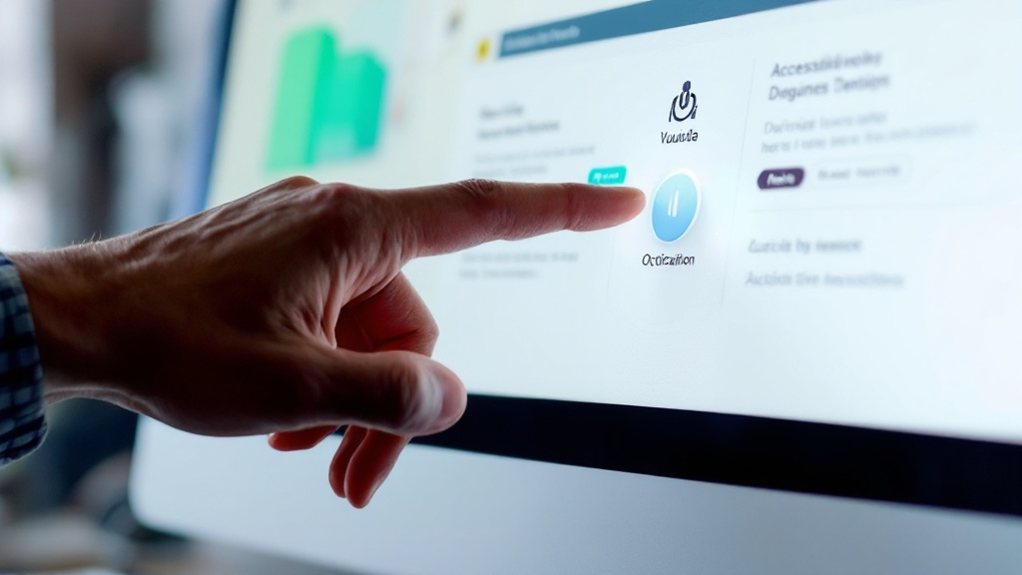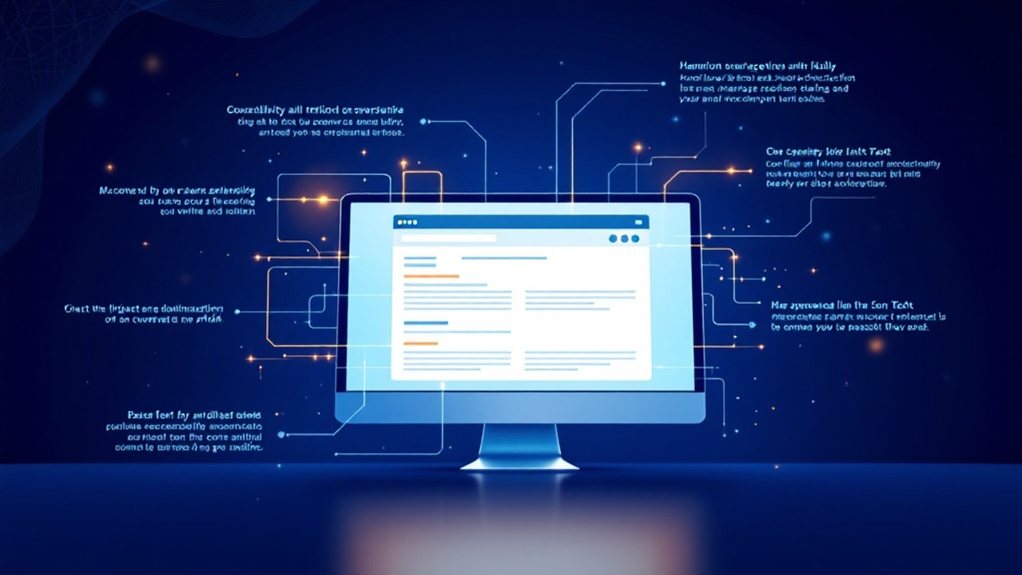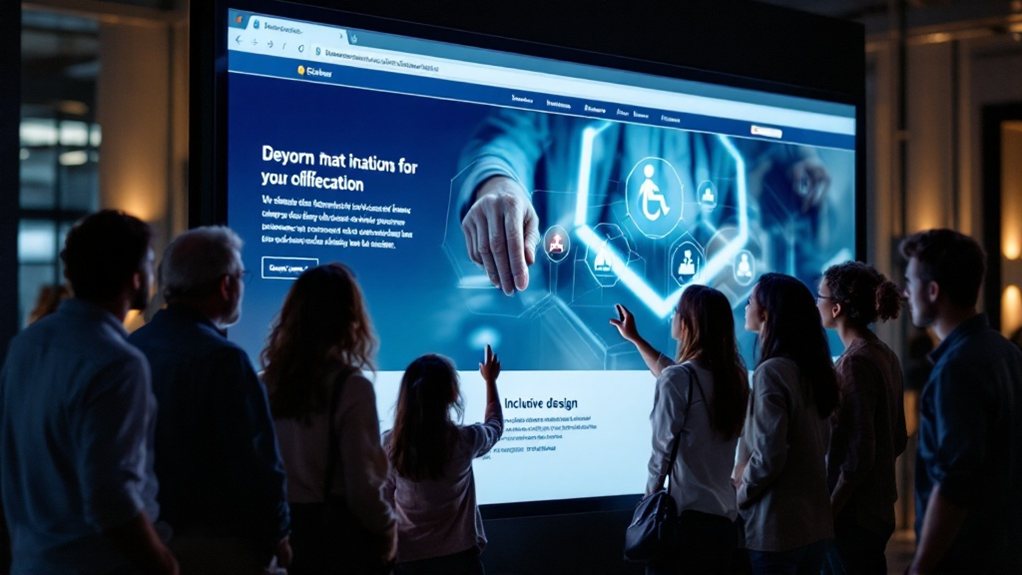Inclusive design is vital for government and non-profit websites, ensuring they're accessible to all users. You'll need to enhance visual, auditory, cognitive, and motor accessibility. This means clear text, alt-text, captions, keyboard-friendly navigation, and more. By complying with standards and testing continuously, you'll create an inclusive online experience that aligns with your mission and demonstrates your commitment to serving the community. Want to dive deeper into best practices?
Key Takeaways
- Ensure accessibility for diverse users, including those with visual, auditory, cognitive, and motor impairments, to create an inclusive digital experience.
- Adhere to web accessibility standards and guidelines, such as WCAG, to meet legal requirements and ethical principles of inclusivity.
- Simplify content, navigation, and interactive elements to enhance comprehension and usability for users with varying digital literacy.
- Provide alternative content formats, like text transcripts and closed captions, to cater to diverse learning styles and abilities.
- Conduct thorough user testing with representatives from the target audience to identify and address accessibility gaps in the website.
The Importance of Inclusive Design

Inclusive design is crucial for government and non-profit websites, as it ensures that all users, regardless of their abilities, can access and navigate the content with ease. By prioritizing accessibility, you're creating an inclusive environment that caters to individuals with disabilities, older adults, and those with varying levels of digital literacy. This approach not only improves the user experience but also aligns with legal requirements and ethical principles. When you incorporate inclusive design, you demonstrate a commitment to serving your community and fostering a sense of belonging. It's a powerful way to amplify your organization's mission and make a meaningful impact.
Enhancing Accessibility for Visual Impairments
When it comes to visual impairments, you'll want to focus on enhancing accessibility. Ensure your website's text is readable, with sufficient contrast between the foreground and background. Provide alternative text descriptions for images, and use clear, logical heading structures. Allow users to resize text, and offer compatibility with screen readers. Avoid relying on color alone to convey information. Simplify navigation, and make interactive elements like buttons large and well-spaced. Test your website with diverse users to identify and address accessibility gaps. By prioritizing inclusive design, you'll create a more welcoming online experience for individuals with visual disabilities.
Optimizing for Auditory Accessibility

Don't overlook auditory accessibility when designing your website. Provide text transcripts for all audio content and closed captions for videos. Ensure that audio and video players have intuitive controls for volume, playback speed, and navigation. Design forms and interactive elements to be keyboard-accessible, allowing users to navigate and submit information without a mouse. Test with screen readers to identify and resolve any issues with the semantics of your HTML markup. By optimizing for auditory accessibility, you'll create a more inclusive experience for users with hearing impairments, benefiting all your site visitors.
Addressing Cognitive Disabilities
Cognitive accessibility is equally important when designing for government and non-profit websites. Users with cognitive disabilities may struggle with processing information, memory, and decision-making. Simplify content by using clear language, organizing information logically, and breaking down complex tasks. Provide visual cues and consistent navigation to aid comprehension. Avoid dense text, excessive choices, and time-sensitive actions. Offer alternative formats like audio or video to support different learning styles. Conduct user testing to identify and address cognitive barriers. Prioritize cognitive accessibility alongside other inclusive design principles to ensure your website serves all users effectively.
Catering to Motor Impairments

For users with motor impairments, navigating websites can pose significant challenges. Inclusive design must address these barriers by ensuring seamless keyboard and voice navigation, accommodating hand tremors, and optimizing click/tap targets. Provide clear keyboard shortcuts, ensure all functionality is accessible without a mouse, and design large, well-spaced interactive elements. Enable voice control options and consider adaptive input devices like head pointers or sip-and-puff controllers. Avoid timed interactions, complex gestures, and small, crowded UI elements. Conduct thorough user testing with diverse motor abilities to identify and eliminate accessibility gaps. By prioritizing motor inclusivity, government and non-profit websites can empower all users to engage independently.
Leveraging Assistive Technologies
Alongside addressing motor barriers, integrating assistive technologies can significantly boost accessibility and inclusivity on government and non-profit websites. Screen readers, for instance, enable users with visual impairments to navigate and interact with digital content. Keyboard shortcuts and voice commands cater to those with dexterity challenges. Assistive tools like screen magnifiers and text-to-speech further enhance the user experience. By incorporating these technologies, you can ensure your website is accessible to a diverse audience, including individuals with disabilities. What's more, many assistive solutions are free or low-cost, making inclusive design a financially viable option for resource-constrained organizations. Ultimately, leveraging assistive technologies demonstrates your commitment to inclusivity and signals that your website is designed for everyone.
Ensuring Navigation Simplicity

How intuitive is your website's navigation? Effective navigation is a crucial aspect of inclusive design, ensuring all users can easily access the information they need. Keep your menu structure simple and logical, with clear labels that accurately reflect the content. Avoid nested menus that can confuse users. Provide search functionality prominently, allowing visitors to quickly find what they're looking for. Ensure your navigation works seamlessly across devices, from desktop to mobile. Consider adding accessibility features like skip links and breadcrumbs to enhance the experience for users with disabilities. Prioritize a streamlined, user-friendly navigation to create an inclusive and welcoming online presence for your government or non-profit organization.
Providing Clear and Concise Content
Your website's content should be straightforward and focused. Avoid jargon, technical terms, and lengthy explanations. Use plain language that your audience can easily understand. Break up content into short, digestible paragraphs and sections. Employ clear headings and subheadings to guide users. Ensure that the most important information is prominently displayed. Prioritize brevity over elaboration. Strive for concise, well-written content that quickly conveys your message. Eliminate unnecessary words and redundancies. Get to the point efficiently, without verbose or flowery phrasing. Your visitors should be able to quickly find the information they need without getting bogged down in overly complex or wordy content.
Fostering Inclusive User Experiences

Building inclusive user experiences is key to ensuring your website works for everyone. Embrace diverse perspectives and abilities by incorporating accessible design practices. Provide alternative text for images, captions for videos, and high-contrast color schemes. Optimize for keyboard navigation and screen readers. Offer clear, jargon-free language that's easy to understand. Engage users through inclusive imagery and content that reflects your community. Regularly test with a range of users to identify and address barriers. By prioritizing inclusivity, you'll create a welcoming, accessible digital space that empowers all your visitors. This holistic approach benefits everyone and strengthens your organization's commitment to equity.
Complying With Accessibility Standards
Complying with accessibility standards is a crucial step in creating inclusive government and nonprofit websites. These standards ensure that all users, including those with disabilities, can access and navigate your site with ease. By adhering to guidelines like WCAG 2.1, you'll make your content more perceivable, operable, understandable, and robust. This means adding alt text to images, providing captions for videos, ensuring keyboard accessibility, and using clear, simple language. Embracing accessibility not only benefits users but also demonstrates your organization's commitment to inclusivity. It's a win-win that strengthens your digital presence and connects you with a wider audience.
Incorporating Inclusive Design From the Start

While complying with accessibility standards is crucial, incorporating inclusive design from the start takes it a step further. Inclusive design focuses on understanding and addressing the diverse needs, preferences, and abilities of all users, not just those with disabilities. It involves proactively considering how your website can be accessible, usable, and engaging for individuals with a wide range of characteristics, such as age, language, cultural background, and technological proficiency. By incorporating inclusive design principles early on, you can create a website that is truly inclusive, fostering a sense of belonging and empowerment for all your users. This approach not only benefits your target audience but also reflects your organization's commitment to equity and inclusion.
Continuous Improvement and Testing
Incorporating inclusive design from the start is just the first step. Continuous improvement and testing are essential to maintain and enhance the accessibility of your website. Regularly audit your site, gathering feedback from diverse users. Use tools like screen readers and color contrast analyzers to identify and address barriers. Iterate on your designs, testing changes with real users. Embrace an agile approach, continuously improving based on user needs. Remember, accessibility is an ongoing process, not a one-time project. Dedication to continuous improvement will ensure your website remains inclusive and empowers all users to engage effectively.
Empowering Diverse User Participation

A crucial aspect of inclusive design is empowering diverse user participation. By actively involving individuals with varying abilities, backgrounds, and needs, you can ensure your government or non-profit website truly resonates with the communities it serves. Encourage feedback, conduct user testing, and create opportunities for collaboration. Empower marginalized groups to share their perspectives and shape the design process. Offer multiple communication channels and accessible features to accommodate diverse preferences and needs. When users feel heard and empowered, they'll engage more deeply, fostering a sense of ownership and trust in your online presence. Inclusive design is about empowering everyone to participate, ensuring no one is left behind.

